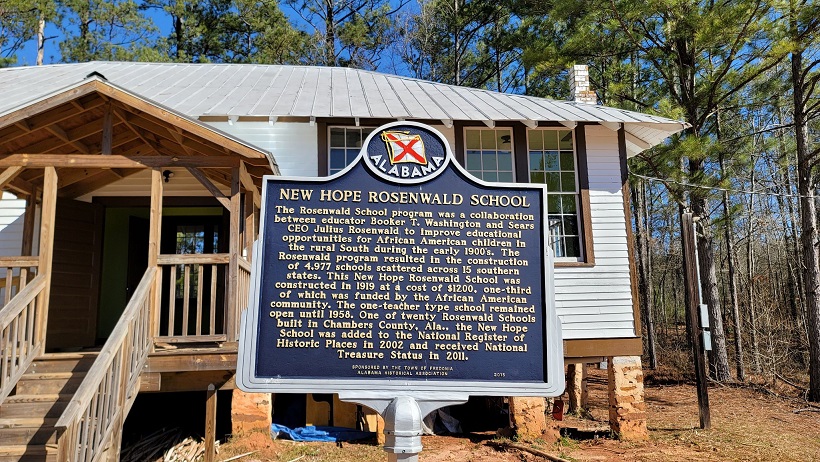Building Science, Architecture faculty digitally preserving Alabama’s disappearing Rosenwald Schools
In the early decades of the 1900s when racial segregation was the norm, almost 400 schools were built in rural Alabama to serve as educational facilities for African American children.
These were known as the Rosenwald Schools and, between 1912-32, they made it possible for African American children to obtain a formal education in a time when doing so would otherwise be nearly an impossibility.
Today, these schools are quickly fading, and a team of researchers from Auburn University’s College of Architecture, Design and Construction is working to digitally preserve and bring attention to the disappearing Rosenwald Schools. Funded by grants from their college, the university’s inaugural Creative Work and Social Impact Scholarship Funding Program and the McWhorter Fund for Excellence, Junshan Liu, Bob Aderholdt Endowed associate professor in the McWhorter School of Building Science, and Gorham Bird, visiting assistant professor in the School of Architecture, Planning and Landscape Architecture, have begun their initial work to digitally document and re-construct four of these schools.
Using the latest digital documentation technology, their end product includes digital Building Information Models, or BIMs, 3D-printed physical models, as-built drawings and online virtual tours of these historic buildings. Their work will be presented through exhibitions to engage the public in civil rights history, teach emerging technologies and promote historical preservation.
“We started last summer,” Bird said. “It is now approaching 100 years since many of these schools were built. It is estimated that 10-12 percent of the original schools remain. Most are falling apart, and there is a pressing need to document and preserve them before they are gone.”
According to the research team, the first six schools in Alabama were built in Lee, Macon and Montgomery counties. The first Rosenwald School was built in Loachapoka in 1914.
In 1917, Julius Rosenwald expanded the project and established the Rosenwald Fund to oversee the establishment of new rural schools. Until 1920, the projects were managed by Tuskegee Institute and designed by Tuskegee architecture faculty Robert R. Taylor and W.A. Hazel. Starting in 1920, management of new schools was taken on by an independent Rosenwald Fund office located in Nashville, Tennessee, and the design of the schools became the responsibility of Samuel L. Smith, a white architect.
“Historic preservation has always been a part of my academic interest,” Bird said. “These schools advanced rural African American education beyond any other system, and they have maintained an impressive community impact. In fact, some alumni still hold reunions to this day.
“Economists have attributed the Rosenwald Schools for creating the African American middle class. Despite the inequities that existed in the Jim Crow South, the remaining Rosenwald Schools serve as a testament to the self-determination and resilience of the communities that worked to build them. This legacy cannot be lost to time.”
Liu leads the digital effort of the project using drones, LiDAR scanners—a system that uses laser to capture dimensional data of an object—360-degree photography, photogrammetry and other digital-based technologies to document and develop intelligent BIM models of these structures.
“We will ultimately create a digital and physical archive of these schools as historic sites that can be shared through exhibits to teach students and others,” Liu said.
Working with partners at the Alabama Historical Commission, or AHC, the project team has identified four Rosenwald Schools in Alabama for this initial work.
The four Alabama schools are geographically diverse, include different models of building type, and condition. The team plans to use this sample of schools to test and perfect the approach for documentation and presentation, in anticipation of seeking more external funds to map, document and preserve the remaining schools in the state and the South.
“The AHC has long wanted to document the remaining Rosenwald Schools,” Bird said. “This project is very much in line with their goals.”
The team has identified sites that are on the National Register of Historic Places that include:
- New Hope School, Chambers County, 1915. One-teacher school type;
- Mount Sinai School, Autauga County, 1919. Two-teacher school type;
- Oak Grove School, Hale County, 1921. Two-teacher school type;
- Tankersley School, Montgomery County, 1922. Three-teacher school type.
“The benefits of this workflow include the expedience of documentation and level of detail and accuracy,” Liu adds. “These benefits allow for a greater number of Rosenwald Schools to be digitally recorded in a shorter period of time with a very high degree of quality.”
The research team has completed a pilot test of documentation through a field survey of one of the Rosenwald Schools, the New Hope School in Chambers County. Three-dimensional LiDAR scanning and aerial photogrammetry was used to develop a digital 3D BIM.
The team also has uncovered archival materials, including the original design documents, through interviews with the president of the New Hope Foundation. An example virtual tour of the Tankersley Rosenwald School in Montgomery County illustrates the pressing need for intervention and preservation of these schools.
The project’s first phase including all four schools is expected to be completed in spring 2023, Bird said.
BY MITCH EMMONS

The New Hope School in Chambers County is one of 400 Rosenwald Schools built between 1912-32 to serve as educational facilities for African American children. A team of Auburn University professors from the College of Architecture, Design and Construction is working to digitally preserve and bring attention to the disappearing schools.
Categories: External Engagement, Creative Scholarship
Back to Articles




